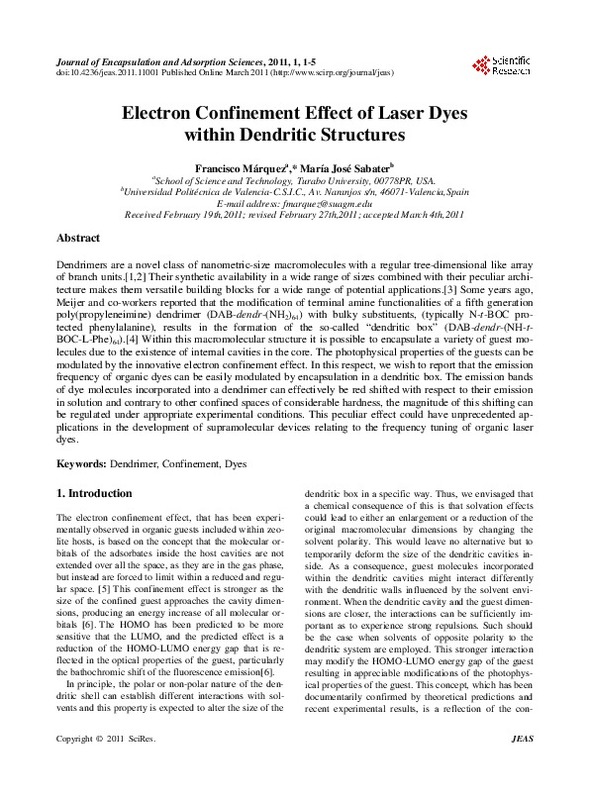JavaScript is disabled for your browser. Some features of this site may not work without it.
Buscar en RiuNet
Listar
Mi cuenta
Estadísticas
Ayuda RiuNet
Admin. UPV
Electron Confinement effect of Laser Dyes within Dendritic Structures
Mostrar el registro sencillo del ítem
Ficheros en el ítem
| dc.contributor.author | Marquez Linares, Francisco Manuel
|
es_ES |
| dc.contributor.author | Sabater Picot, Mª José
|
|
| dc.date.accessioned | 2013-04-30T11:50:40Z | |
| dc.date.available | 2013-04-30T11:50:40Z | |
| dc.date.issued | 2011 | |
| dc.identifier.issn | 2161-4873 | |
| dc.identifier.uri | http://hdl.handle.net/10251/28346 | |
| dc.description.abstract | [EN] Dendrimers are a novel class of nanometric-size macromolecules with a regular tree-dimensional like array of branch units.[1,2] Their synthetic availability in a wide range of sizes combined with their peculiar architecture makes them versatile building blocks for a wide range of potential applications.[3] Some years ago, Meijer and co-workers reported that the modification of terminal amine functionalities of a fifth generation poly(propyleneimine) dendrimer (DAB-dendr-(NH2) 64) with bulky substituents, (typically N-t-BOC protected phenylalanine), results in the formation of the so-called ¿dendritic box¿ (DAB-dendr-(NH-tBOC-L-Phe)64).[4] Within this macromolecular structure it is possible to encapsulate a variety of guest molecules due to the existence of internal cavities in the core. The photophysical properties of the guests can be modulated by the innovative electron confinement effect. In this respect, we wish to report that the emission frequency of organic dyes can be easily modulated by encapsulation in a dendritic box. The emission bands of dye molecules incorporated into a dendrimer can effectively be red shifted with respect to their emission in solution and contrary to other confined spaces of considerable hardness, the magnitude of this shifting can be regulated under appropriate experimental conditions. This peculiar effect could have unprecedented applications in the development of supramolecular devices relating to the frequency tuning of organic laser dyes. | es_ES |
| dc.description.sponsorship | Generous financial support from NASA (Grant NAG10-335) is gratefully acknowledged. Financial support from US Department of Energy through the Massey Chair project at University of Turabo is also acknowledged. | |
| dc.language | Inglés | es_ES |
| dc.publisher | Scientific Research Publishing | es_ES |
| dc.relation.ispartof | Journal of Encapsulation and Absorption Sciences | es_ES |
| dc.rights | Reconocimiento - No comercial - Compartir igual (by-nc-sa) | es_ES |
| dc.subject | Dendrimer | es_ES |
| dc.subject | Confinement | es_ES |
| dc.subject | Dyes | es_ES |
| dc.title | Electron Confinement effect of Laser Dyes within Dendritic Structures | es_ES |
| dc.type | Artículo | es_ES |
| dc.identifier.doi | 10.4236/jeas.2011.11001 | |
| dc.relation.projectID | info:eu-repo/grantAgreement/NASA//NAG10-335/ | es_ES |
| dc.rights.accessRights | Abierto | es_ES |
| dc.contributor.affiliation | Universitat Politècnica de València. Instituto Universitario Mixto de Tecnología Química - Institut Universitari Mixt de Tecnologia Química | es_ES |
| dc.description.bibliographicCitation | Marquez Linares, FM.; Sabater Picot, MJ. (2011). Electron Confinement effect of Laser Dyes within Dendritic Structures. Journal of Encapsulation and Absorption Sciences. 1:1-5. https://doi.org/10.4236/jeas.2011.11001 | es_ES |
| dc.description.accrualMethod | S | es_ES |
| dc.relation.publisherversion | http:/dx.doi.org/10.4236/jeas.2011.11001 | es_ES |
| dc.description.upvformatpinicio | 1 | es_ES |
| dc.description.upvformatpfin | 5 | es_ES |
| dc.type.version | info:eu-repo/semantics/publishedVersion | es_ES |
| dc.description.volume | 1 | es_ES |
| dc.relation.senia | 215154 | |
| dc.contributor.funder | National Aeronautics and Space Administration, EEUU | |
| dc.contributor.funder | U.S. Department of Energy |








